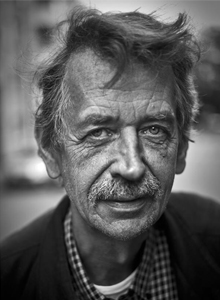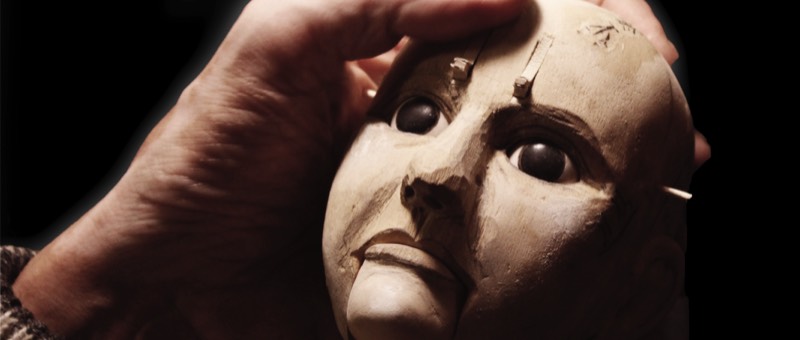
THOMAS LUNDQVIST
______________________________________________________________________________
BUNRAKU, IL SUPER ATTORE
What bunraku is?
For centuries, Japan has taken everything came from outside. At that stage some historical puppeteers developed a unique technique. Until then, a man could move by himself, as usual, one or two puppets; in these new schools puppets began super expressive trying to trace the movements of human being.
Moving puppets in three people is a puppet theater experience that corresponds in some respects to the acting, where the rhythms and relationships woven between the text and the actors are crucial. Likewise, three puppeteers who move the same puppet dramaturgically must try and find a balance, a hierarchy, a sense of movement at all moment.
Then the construction of bunraku is very different from that of a puppet where the force of gravity acts on the will of the puppeteer; in the Bunraku theatre (as in puppets table) the weight is imaginary and the “vision” of a gravity is the action. This theatre has to be interpreted as the acting of the manipulation.
The stage and the timetable
In the lab the participants will follow the necessary steps to make a bunraku, with body, arms and legs.
It is not necessary a special experience in the field of sculpture; but it is required, in order to follow the teacher, a discrete manual skill.
There will be a period of 18 days to complete the preparation of bunraku, with a daily frequency of about seven / eight hours.
This workshop is therefore an important opportunity for all those who face whit the technical problems of puppets movement; the stage will not only solve the specific problems of bunraku but will provide information and special knowledge (mechanisms of the head) that can be used in many other aspects and construction techniques.
The stage in details
1. knowledge and short historical notes on the technique of Japanese bunraku
2. how to use the few tools needed for cutting (two knives)
3. carving wooden parts (head, arms, hands and legs)
4. finding a personal project of bunraku (study of a character)
5. assembly of mobile mechanisms (eyes, mouth, head) attached to the inside of the head
6. construction of the whole body
7. preparation of a special film that covers the head like a typical porcelain heads of Japanese Bunraku
8. Learning alternative bunraku assembly for a use with a single puppeteer
The organization will provide the material for the construction, generic tools (clamps, saws, drills, etc.). The two knives must be bought separately and will be provided by the organization.
What bunraku is?
For centuries, Japan has taken everything came from outside. At that stage some historical puppeteers developed a unique technique. Until then, a man could move by himself, as usual, one or two puppets; in these new schools puppets began super expressive trying to trace the movements of human being.
Moving puppets in three people is a puppet theater experience that corresponds in some respects to the acting, where the rhythms and relationships woven between the text and the actors are crucial. Likewise, three puppeteers who move the same puppet dramaturgically must try and find a balance, a hierarchy, a sense of movement at all moment.
Then the construction of bunraku is very different from that of a puppet where the force of gravity acts on the will of the puppeteer; in the Bunraku theatre (as in puppets table) the weight is imaginary and the “vision” of a gravity is the action. This theatre has to be interpreted as the acting of the manipulation.
The stage and the timetable
In the lab the participants will follow the necessary steps to make a bunraku, with body, arms and legs.
It is not necessary a special experience in the field of sculpture; but it is required, in order to follow the teacher, a discrete manual skill.
There will be a period of 18 days to complete the preparation of bunraku, with a daily frequency of about seven / eight hours.
This workshop is therefore an important opportunity for all those who face whit the technical problems of puppets movement; the stage will not only solve the specific problems of bunraku but will provide information and special knowledge (mechanisms of the head) that can be used in many other aspects and construction techniques.
The stage in details
1. knowledge and short historical notes on the technique of Japanese bunraku
2. how to use the few tools needed for cutting (two knives)
3. carving wooden parts (head, arms, hands and legs)
4. finding a personal project of bunraku (study of a character)
5. assembly of mobile mechanisms (eyes, mouth, head) attached to the inside of the head
6. construction of the whole body
7. preparation of a special film that covers the head like a typical porcelain heads of Japanese Bunraku
8. Learning alternative bunraku assembly for a use with a single puppeteer
The organization will provide the material for the construction, generic tools (clamps, saws, drills, etc.). The two knives must be bought separately and will be provided by the organization.
______________________________________________________________________________

______________________________________________________________________________
Thomas Lundqvist - Svezia
Puppet designer and builder Thomas is the leader of Svarta Katten, the Swedish company founded in 1986. This company, besides of living in Sweden, a poor territory of puppetry traditions, has managed to create a recognizable personal style, a technique composed of a technical mixture of various types of world puppetry.
In each composition the teacher Thomas reaches that particular drama that has its roots in the Western and Eastern tradition. He plays with the irony of his shows so much human activity, the light aspects of the human life. His work reflects an artistic line where the drama is strongly linked to the gimmick where each technique found a concept, a feeling.
It has been already years that he trains throughout Europe, being the only westerner, who has study the bunraku technique so in-depth. He is a superfine sculptor for the aesthetic beauty and the technical peculiarities of his pieces: some of his puppets are in the National Puppet Museum of Stockholm.
italian version
Puppet designer and builder Thomas is the leader of Svarta Katten, the Swedish company founded in 1986. This company, besides of living in Sweden, a poor territory of puppetry traditions, has managed to create a recognizable personal style, a technique composed of a technical mixture of various types of world puppetry.
In each composition the teacher Thomas reaches that particular drama that has its roots in the Western and Eastern tradition. He plays with the irony of his shows so much human activity, the light aspects of the human life. His work reflects an artistic line where the drama is strongly linked to the gimmick where each technique found a concept, a feeling.
It has been already years that he trains throughout Europe, being the only westerner, who has study the bunraku technique so in-depth. He is a superfine sculptor for the aesthetic beauty and the technical peculiarities of his pieces: some of his puppets are in the National Puppet Museum of Stockholm.
italian version
______________________________________________________________________________
the cost workshop is € ………………… + Iva + 10 € insurance
date to be defined
It is important to confirm as soon as possible - your participation to - the course since places are limited to 15
As confirmation is given for registration, a € 250 deposit is required.
registration form
date to be defined
It is important to confirm as soon as possible - your participation to - the course since places are limited to 15
As confirmation is given for registration, a € 250 deposit is required.
registration form